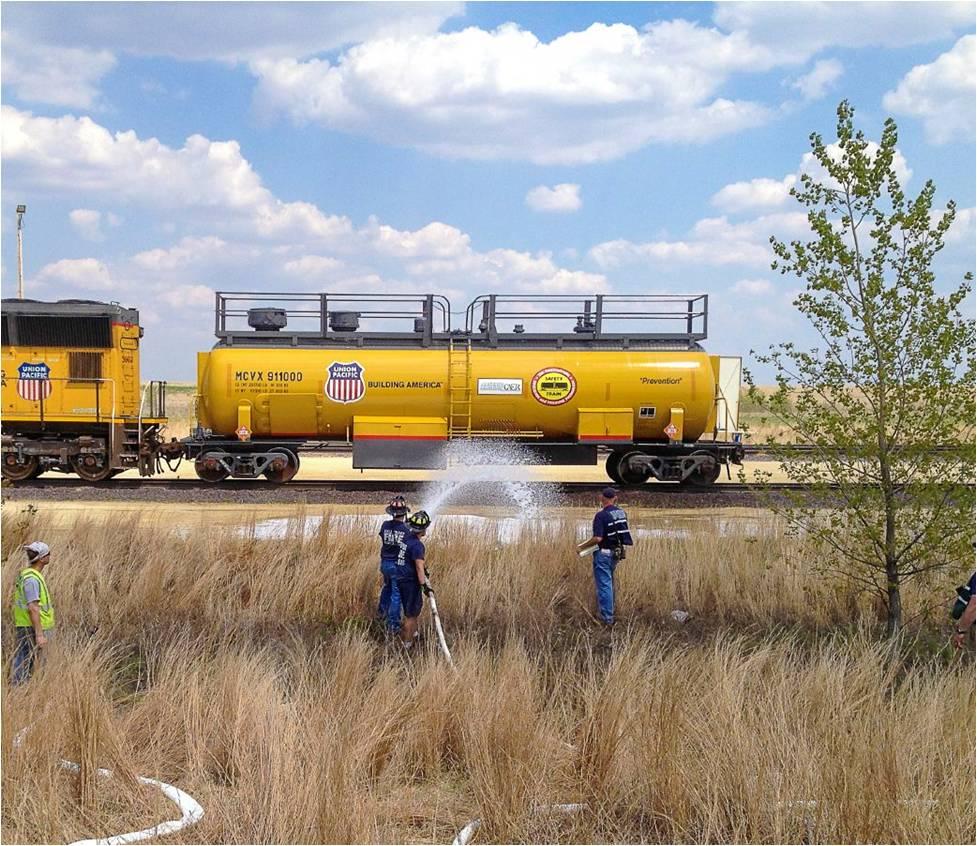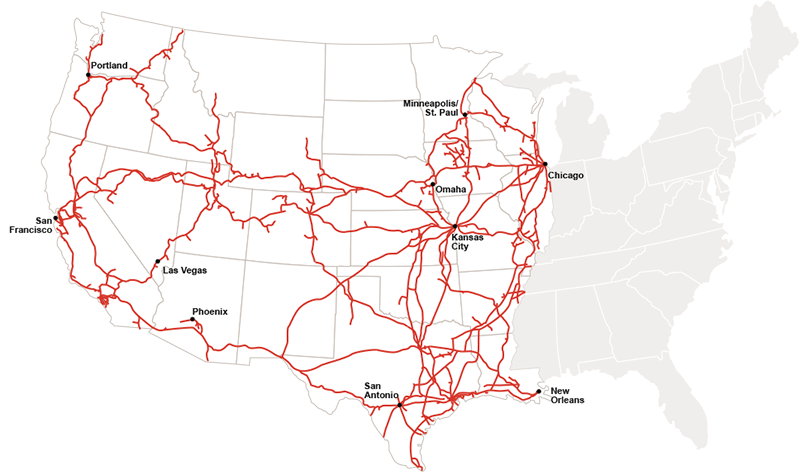Working with First Responders

Shipping hazardous materials by rail is the safest mode of land transportation. According to the AAR, railroads deliver hazardous materials safely 99.999 percent of the time. Union Pacific is mindful of the potential consequences of an accident, which is why we have a long-standing commitment to training first responders in our communities.
Jump to:
Hazardous Materials Management Group
The Union Pacific Hazardous Materials Management Group (HMM) consists of experts in hazardous material transportation safety, securement and response. They are dedicated to a four-part mission prevention, preparedness, response and recovery.
Prevention
Union Pacific's HMM team members regularly inspect tank cars moving on the UP network, performing thousands of inspections annually. In each inspection, an HMM team member examines fittings, markings, safety appliances, waybills and identification placards to ensure they meet DOT regulations.
Additionally, Union Pacific managers, outside contractors, customers and regulators work together to inspect a large number of tank cars in a defined geographic area. Locations carrying significant hazmat volumes are chosen for tank car inspection blitzes, with roughly 10 blitzes performed annually across the UP network.
HMM is responsible for training employees about hazardous materials safety. U.S. Department of Transportation-defined "hazmat employees" are required to be trained in the safe handling of hazardous materials. Train crews are required to carry a copy of Instructions for Handling Hazardous Materials, provided by HMM, while operating a train carrying hazmat.

Preparedness
Preparation is critical to an appropriate incident response. HMM develops the Union Pacific Hazardous Materials Emergency Response Plan (HMERP), a performance-based plan providing guidance about reporting a release as well as a list of training requirements for those responding to an incident. Each of the company’s geographical operating units undergoes an annual unannounced drill to ensure all aspects of the HMERP are in place and being followed by Union Pacific employees. Drill and exercise requirements are managed by HMM.
Providing no-cost training to public responders is Union Pacific's most substantial preparedness effort. Between 2013 and 2016, Union Pacific trained 28,064 local, state and federal first responders on ways to minimize the impact of a derailment in their communities.
Having cataloged every fire department that may respond to an incident along the Union Pacific network, HMM team members reach out to fire departments on an annual basis to offer training or information to assist fire departments in their preparation for a potential incident. Training consists of classroom and hands-on activities using a specially designed training trailer or training tank car. Trainees learn how to contact the railroad during an emergency, how to read shipping documentation, derailment safety considerations and what assets the railroad can provide in the event of an incident. HMM performs large scale training events in collaboration with Union Pacific's partners in TRANSCAER (Transportation Community Awareness and Emergency Response).
Response
The response process used by HMM is designed to be easily incorporated into public response incident command structure. This process requires analyzing the problem, planning the response, implementing the plan, and evaluating and adjusting the response as necessary. Union Pacific's Response Management Communication Center (RMCC) is an around-the-clock security response center where critical call dispatchers manage calls from the public, law enforcement and others who are reporting emergencies and other incidents on Union Pacific's 32,000-mile network. RMCC, available at 888-877-7267, follows all regulations regarding notification of local, state and federal agencies in the event of an accident and works closely with first responders throughout an incident.
Union Pacific has approximately 30 highly trained hazardous materials responders. Additionally, we rely on a network of private response contractors who are carefully vetted and audited on an annual basis to ensure a constant state of readiness. Most of these contractors are qualified with firefighting or United States Coast Guard Oil Spill Recovery Organization (OSRO) certifications. OSRO-certified contractors have demonstrated expertise and equipment to handle oil spills on land and water. Contractors have access to the equipment (boats, boom, skimmers, vacuum trucks, storage tanks, heavy equipment) necessary to respond to a hazardous materials incident.
To supplement the response, HMM has air monitoring contractors who can be quickly deployed to provide real-time data to public responders. Union Pacific works closely with community leadership throughout the response process. Additionally, HMM can deploy contractors who are subject-matter experts in toxicology, industrial hygiene, medicine, nursing and environmental protection. These specialty contractors can work in the communities impacted by an incident and in concert with first responders to ensure a safe response.
HMM invested in response equipment in the form of firefighting trailers, foam caches, air monitoring equipment and specialty tools to ensure resources are readily available.
Recovery
Once an incident has been stabilized, recovery begins. If a tank car has been damaged and cannot travel safely on the railroad, the contents must be transferred to an undamaged car. Union Pacific is the only railroad that owns and operates all of the equipment necessary to transfer any liquid or compressed gas from one tank car to another. Once the tank car is liquid free, HMM will clean and purge the damaged car, ensuring it can be safely repaired or dismantled.
Once all hazardous materials have been removed from the incident site, HMM will transition the project to the Union Pacific Site Remediation Group for remediation and closure with regulatory agencies.
The final aspects of recovery include a debriefing with the public responders and an internal post-incident analysis. These activities are an invaluable means of improving the group's overall capability to respond to a hazmat-related incident.
Hazmat Response Resources
Union Pacific developed a reserve of materials along our route for deployment in the event of a hazardous materials incident. Resources include more than 450,000 feet of boom, which floats in the water to absorb oil and other hydrocarbons, transfer trucks, liquid-only transfer trailers, fire trailers and foam caches.
We also employ approximately 30 highly-trained hazardous materials responders ready to move in the case of a hazardous materials incident. They are supported by a network of private response contractors who are highly qualified and often have firefighting or United States Coast Guard Oil Spill Recovery Organization certifications.
We maintain a 24-hour emergency hotline, to the Response Management Communication Center (RMCC), available at 888-877-7267, so communities can quickly communicate with us in the event of a derailment or hazardous materials release.
Additionally, starting in 2014, Union Pacific introduced first responders on its rail network to AskRail, a real-time mobile application produced by the Association of American Railroads (AAR). The invitation-only application allows first responders to query the contents of a rail car with a simple rail car ID search and see whether the rail car is carrying hazardous material. Responders can also find emergency contact information, and a list of the 125 hazardous materials most commonly shipped by rail.
